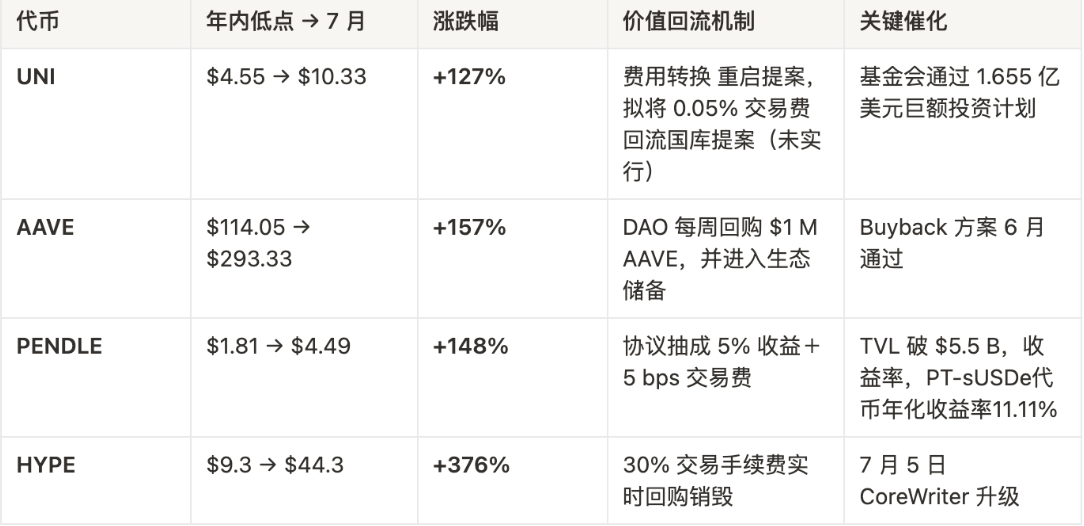From “Air” to “Cash Flow”: The Rise of Utility Tokens After the VC Bubble Burst
In early 2025, as secondary market liquidity dried up, a wave of “story + airdrop”-driven altcoins saw their bubbles burst in brutal fashion.
Countless altcoins tumbled to new lows, while Bitcoin’s market cap dominance surged to a five-year high of 62.1%, and the Altcoin Season Index sank to a record-low of 4 in May 2023.
Yet, “utility tokens” like Uniswap (UNI), Aave (AAVE), Pendle (PENDLE), and Hyperliquid (HYPE) drew capital contrary to broader market trends, with both price and on-chain revenue climbing. These tokens share the following characteristics: real, auditable protocol cash flow, with value returned to token holders through mechanisms like buybacks, revenue sharing, or staking rewards.
This article explores the logic of capital flows following the VC bubble burst and uses four standout projects as case studies to examine how the “on-chain P/E era” is transforming crypto valuation paradigms.
Market Background: As Narratives Lose Steam, Cash Flow Becomes Scarce
- VC Slowdown: In Q2 2025, global crypto fundraising plunged to $4.99 billion, down another 21% quarter over quarter—the lowest single-quarter figure since 2020—as investors turned wary of “concept-only” hype.
- Capital flows back to blue-chip DeFi: While Bitcoin remained strong and held the dominant position, fragmentation within DeFi increased. Protocols with a closed-loop “revenue–distribution” model saw their TVL and trading volumes continue to climb. Pendle’s TVL topped $5.59 billion in July, nearly tripling so far this year.
- Valuation anchors shift: In a traditional risk-off cycle, investors are more inclined to pay for quantifiable cash flow than mere narrative premiums.
What Are “Utility Tokens”?
Definition: These are tokens whose holders can share protocol revenue (fee capture) or indirectly boost each token’s “on-chain EPS” (provable earnings per token) through mechanisms such as buybacks/burns or staking profit-sharing.
Typical Models
- Fee Switch / Trading Revenue Sharing: Returns protocol fees to holders or funds buybacks (e.g., GMX).
- Lending Spread & Liquidation Fees: Routes spread and liquidation rewards to the treasury for buybacks (AAVE, Maker).
- Yield Tokenization: Slices and trades future yield, with a protocol fee on each transaction (Pendle).
- Infrastructure Fuel: High-frequency matching engine fees are instantly used for buyback and burn (HYPE).
A Quick Look at Four Leading Cases

Breakdown: How Does Cash Flow Drive Valuation Recovery?
Uniswap (UNI)
Historically, UNI was seen solely as a “governance token.” Later, the Uniswap Foundation passed a major $165.5 million investment initiative, allocating funds as follows:
· $95.4 million for grants (developer programs, core contributors, validators);
· $25.1 million for operations (team expansion, governance tooling);
· $45 million for liquidity incentives.
To date, the $UNI token still lacks effective value-capture or token buyback mechanisms.
Aave (AAVE)
The Aave DAO approved weekly buybacks of approximately $1 million worth of AAVE using protocol surplus funds, with purchased tokens locked in the DAO treasury:
- The debut week saw the token jump 13% intraday and trading volumes double.
- Lending spreads and liquidation fees deliver stable protocol cash flow. With V3 TVL up 32% year over year, the buyback program is well-funded over the long term.
Pendle (PENDLE)
Pendle transformed the “future yield” derivatives narrative into a live trading market:
- The protocol collects a 5% yield fee plus a 5 bps trading fee, generating daily, auditable income.
- High-yield strategies (for example, stETH YT yields topping 11%) attracted significant capital in the low-rate environment.
Hyperliquid (HYPE)
As a high-frequency matching DEX, Hyperliquid rolled out CoreWriter precompilation in July, enabling HyperEVM contracts to submit orders, settle, and interact with the CLOB, all with an on-chain fee buyback and burn system:
- During the upgrade week, both on-chain active addresses and trading volume reached new all-time highs.
- Instant value return and large high-frequency trading fees made HYPE a high-beta “on-chain cash flow” asset.
Three Moats for Surviving Bear Markets
- Predictable cash flow: On-chain revenue and expenses are auditable; DAO decisions are fully transparent, reducing information asymmetry.
- Buyback and profit-sharing loop: The link between protocol revenue and token value is hardcoded into smart contracts, much like stock buybacks or dividends in the traditional financial world.
- Institutional appeal: Quantifiable metrics (P/S, P/E) reduce valuation uncertainty and support market making and structured product creation.
Conclusion
After the VC narrative faded, the market is now repricing “verifiable cash flow.”
Utility tokens combine on-chain revenue, token value, and governance power—making them rare assets that endure across market cycles.
As leading DeFi protocols roll out Fee Switches, buybacks, or surplus-sharing, it signals a shift in crypto market valuation models, moving from narrative-driven to cash flow-driven approaches.
Disclaimer:
- This article is reprinted from hissing. Copyright remains with the original author. For reprint-related concerns, please contact the Gate Learn Team, who will follow up according to established procedures.
- Disclaimer: The views and opinions expressed are solely those of the author and do not constitute investment advice.
- Other language versions of this article are translated by the Gate Learn Team. Reproduction, distribution, or plagiarism of the translated article is not permitted without explicit mention of Gate.
Related Articles

The Future of Cross-Chain Bridges: Full-Chain Interoperability Becomes Inevitable, Liquidity Bridges Will Decline

Solana Need L2s And Appchains?

Sui: How are users leveraging its speed, security, & scalability?

Navigating the Zero Knowledge Landscape

What is Tronscan and How Can You Use it in 2025?
